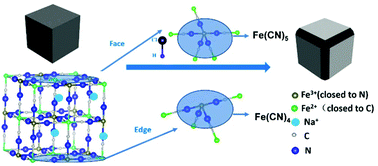Selective edge etching to improve the rate capability of Prussian blue analogues for sodium ion batteries†
Abstract
Prussian blue analogues (PBA) possess a high theoretical specific capacity for sodium ion batteries. However, cycling PBA to a high current density causes severe capacity fading. Here, we develop a selective edge-etching approach to tackle this long-standing issue of poor rate capability. Well-crystallized PBA particles were produced by hydrothermal treatment of a sodium hexacyanoferrate precursor dissolved in muriatic acid solution, which were then eroded in hydrochloric acid solution to promote selective etching along the edges of the PBA crystals. The defect concentration ([Fe(CN)6]4−) on the edge is denser than that at the face or corner, which stimulates the preferred etching of edges via the defect-induced heterogeneous mechanism. Due to the increasing exposed surface area and active sites, the etched PBA display much improved electrochemical performance with a capacity of 167 mA h g−1 at a current density of 5 mA g−1 and a capacity retention of 82.7% when the current density was increased to 40 mA g−1, demonstrating fast sodium ion transfer and high rate capability.

- This article is part of the themed collection: 2019 Inorganic Chemistry Frontiers HOT articles


 Please wait while we load your content...
Please wait while we load your content...